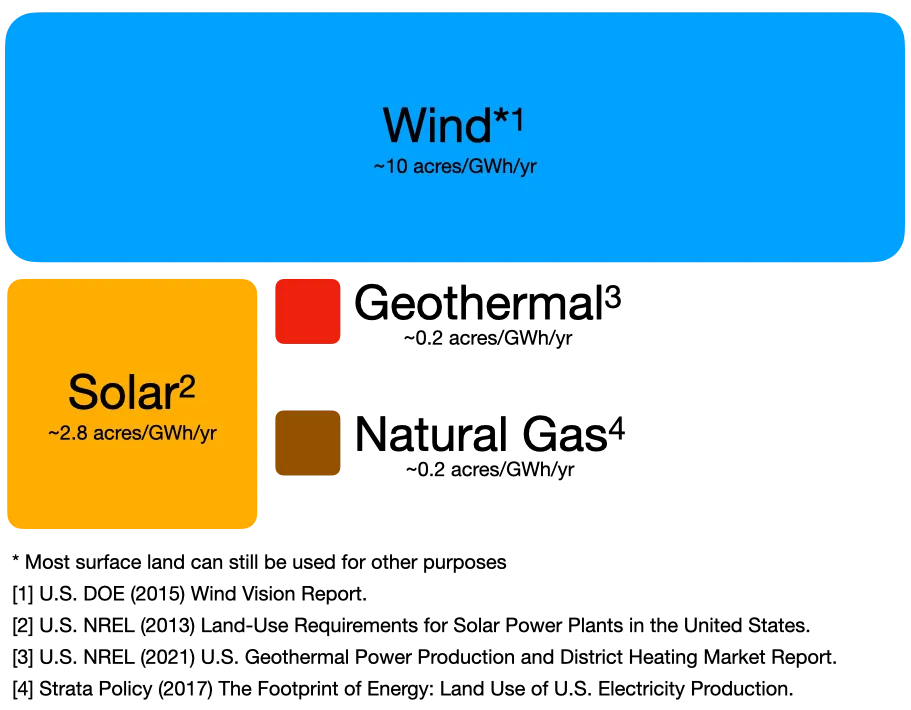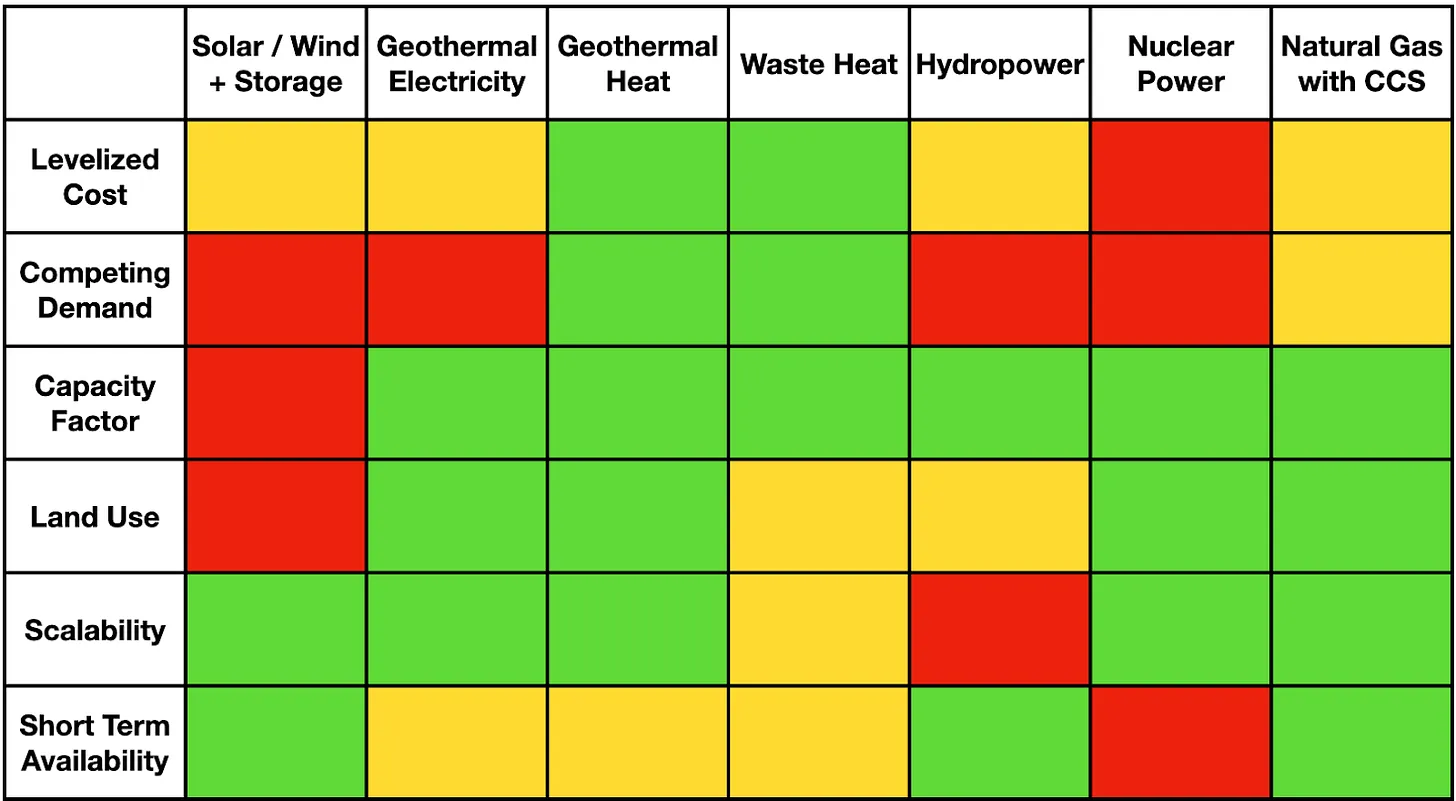Direct Air Capture & The Energy Question
At its core, Direct Air Capture (DAC) is an energy problem.
DAC is energy-intensive, and deploying it to the tune of millions of tons per year and beyond will require tremendous amounts of clean, low-cost energy. In this post, we’ll evaluate a variety of energy inputs with pathways to power DAC at scale, and highlight key trade-offs with respect to factors like cost, intermittency, land use, abundance, and competing demand.
Energy Requirements for DAC
DAC processes typically consist of an initial capture step, during which CO2 is separated from the air, and a regeneration step, during which concentrated CO2 is released for storage or utilization. The capture process typically requires electricity for the operation of fans and auxiliary equipment, while regeneration requires either electricity or heat. Additional electricity is typically needed for CO2 compression downstream of the DAC process to prepare the released CO2 for transport or sequestration.
While DAC technologies vary, regeneration (the separation of the CO2 from the initial capture agent) is typically the most energy-intensive part of a DAC process.
Image: Source - AirMyne, Direct Air Capture process steps (energy consumption, %)
Intermittent Renewables
As the energy transition gains momentum, it’s understandable that many DAC companies are turning to electricity from solar and wind to power their systems. Rather than highlight the many benefits of solar and wind, which have been extensively covered already, we want to consider some of the practical constraints of these energy sources.
Intermittency. Solar and wind are inherently intermittent, but capex-heavy DAC processes will likely require continuous operation to be economical. Energy storage offers a path to use surplus intermittent power to run DAC operations continuously, but building sufficient on-site energy storage for continuous operation of a DAC facility requires considerable upfront expense, adding to the levelized costs of DAC.
Opportunity Costs for Grid-Sourced Power. Using grid-connected solar and wind energy to power DAC deprives essential sectors of the opportunity to use that energy to decarbonize. Powering DAC with solar and wind from the grid might only be justifiable in situations where large surpluses of intermittent power remain even after addressing competing demand from other sectors (e.g. industrial decarbonization, data centers, and the like). Such a situation is unrealistic within the next few decades in many parts of the world.
Land Use. Relative to other energy sources, solar and wind have a large physical footprint. If large-scale DAC projects must power their operations with dedicated solar and wind, the high energy intensity of DAC technologies and the low power density of solar and wind creates land use requirements that become challenging or even prohibitive for large-scale DAC projects. DAC project developers requiring dedicated solar and wind should expect to face similar non-technical land access barriers similar to those already affecting utility-scale solar and wind projects, such as zoning restrictions (setbacks, easements, rights-of-way), environmental regulations, and local community resistance. Moreover, the land needed for solar and wind to power DAC should not compete with more urgent land needs, like agriculture.
Image: Source - AirMyne, Land Use by Energy Type
In highlighting these constraints for intermittent renewables, we don’t seek to diminish their benefits. Scaling DAC will require a significant amount of electricity, even in technologies that leverage heat, and solar and wind will likely play an essential role in the deployment of commercial-scale DAC projects.
However, given the constraints of powering DAC with intermittent renewables as described above, DAC technologies having the option to run on clean electricity, while also retaining the option to use heat, will give project developers the most flexible options for accessing low-cost power in the widest variety of energy system scenarios. This includes both scenarios where solar, wind, and storage are truly abundant, and scenarios where these resources do not deploy as quickly or abundantly as hoped.
Other Energy Approaches are Possible, and Necessary
A variety of energy pathways will be needed to allow DAC to deploy at scale. Below, we explore and present the most promising of those options.
Geothermal Energy: Geothermal energy is a firm, clean, reliable, and abundant resource with a relatively low land footprint. While high exploration costs have limited geothermal power deployments in the past, the application of techniques from the oil and gas industry to geothermal exploration and drilling is rapidly improving its cost profile. Geothermal energy is underutilized relative to its global abundance; this is especially true for low-temperature and moderate-temperature geothermal resources which are widespread but almost totally unused due to their poor electrical conversion efficiencies. Critically, using geothermal heat as a direct input for thermal DAC processes could bypass the poor heat-to-electricity conversion efficiencies typically seen in geothermal power production, opening an opportunity to run DAC using geothermal resources which are otherwise uneconomical for power generation but well-suited for DAC processes. In fact, using geothermal heat for its thermal value appears to offer the lowest energy cost of any firm renewable source — a topic for another post.
Waste Heat: Refineries, thermal power plants, data centers, and other industrial facilities reject waste heat to the environment via cooling towers and ponds. If this heat can be recovered, energy which would otherwise have been wasted can be applied to thermal DAC processes with compatible temperature requirements. Coincidentally, facilities generating large amounts of waste heat often have large CO2 footprints of their own; co-locating DAC at facilities with waste heat as well as point-source CCS could lower the overall emissions footprint of the host facility while allowing for cost-savings from sharing CO2 compression and transport infrastructure.
Hydropower: In regions where hydropower is available, it can provide clean, reliable, abundant, low-cost electricity for DAC. However, its availability is geographically limited and typically seasonal, making it a strong option only in certain regions and scenarios. As data centers, hydrogen production, steelmaking, and other power-intensive processes gradually seek the benefits of hydropower, the opportunity costs of using hydropower for DAC may need to be considered.
Nuclear Power: Nuclear fission generates high-temperature heat which is readily converted to electricity. On purely technical merits, nuclear energy could be an ideal energy source for DAC, generating heat, power, or both with minimal surface footprint and nearly limitless scaling potential. However nuclear energy faces high costs and non-technical barriers to deployment. Furthermore, the opportunity costs of using nuclear energy to power DAC rather than other decarbonization efforts must be considered.
Natural Gas with Carbon Capture & Sequestration (CCS): While the narrative of using fossil energy to power DAC is problematic to many, natural gas should be carefully considered as a power source for DAC, particularly stranded gas resources in regions with strong sequestration potential. Natural gas is abundant and low-cost, and pairing it with CCS can create both heat and power suitable for DAC operations. In order to ensure emissions are net negative, significant effort may be required to ensure the performance of the CCS systems are suitable and that any methane leakage is tracked and managed.
Image: Source - AirMyne, Relative Suitability to Power DAC by Energy Type
The Path Forward
In our analysis of these energy pathways, we find one unifying theme: every energy source generates or can readily produce low-temperature heat, either directly or with high conversion efficiencies (e.g. through resistive heating). However, the converse is not true; converting low-temperature heat into electricity or high-temperature heat always requires an additional energy cost. By default, this means low-temperature heat is the cheapest, most abundant form of energy in any energy-system context or scenario. And because only a subset of economic activities use low-temperature heat as a preferred energy input, it is unlikely that low-temperature heat will face the competing demand we currently see for clean electricity.
This conclusion has profound implications for DAC. It suggests that powering DAC primarily by low-temperature heat, and with the smallest amount of electricity possible, offers the greatest optionality for accessing low-cost energy in any region or energy scenario. This thesis drove many of our R&D decisions at AirMyne, and is why we’ve designed our regeneration step around low-temperature heat.
Of the energy inputs considered, geothermal heat, waste heat, hydropower electricity, and natural gas with carbon capture appear most suitable for providing energy to create low-temperature heat for commercial DAC projects in the short term. These resources generally have a balanced profile concerning cost, abundance, land use, and competing demand. Geothermal and nuclear offer promising abundance and economics for large-scale global DAC deployment in the long term.
Geothermal heat appears especially compelling due to its low costs, continuous delivery, low emissions, and lack of competing demand. Intermittent renewables like solar and wind will no doubt play a major role in powering the DAC’s electricity needs, but their intermittency, competing uses, and land requirements may limit their applicability as the primary energy input for DAC in the foreseeable future.
Thoughts? Don’t hesitate to reach out. And for more, give us a follow on LinkedIn.



